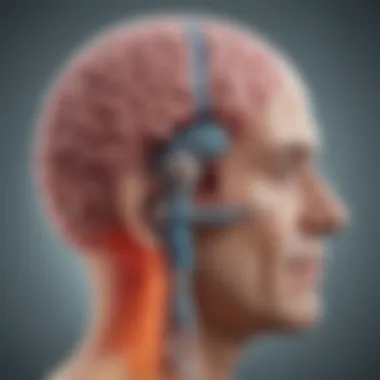Prognosis of Lung, Liver, and Brain Cancer: Insights


Intro
Cancer remains a foremost challenge in modern medicine, impacting countless individuals and families. Understanding the prognosis of lung, liver, and brain cancers is paramount due to their distinct characteristics and common uncertainties surrounding treatment and outcomes. Each of these cancers presents multifaceted challenges, from the way they develop and spread to the methods available for early detection and treatment.
The Burden of Disease
Globally, these cancers do not only claim lives but also lead to significant morbidity. Lung cancer, often linked to smoking and environmental pollutants, stands as the leading cause of cancer-related deaths worldwide. Liver cancer, frequently associated with chronic hepatitis infections, complicates the burden particularly in developing regions. Meanwhile, brain cancer strikes a more diverse demographic, including children and adults alike, complicating the path of treatment with its varied forms and aggressiveness.
Objectives of the Article
This article aims to unravel the complexities surrounding the prognosis of these three cancer types. It does not merely regurgitate the conventional wisdom; rather, it digs deeper into the nuances of each disease, from genetic markers to psychosocial factors influencing patient outcomes. By crafting a narrative that bridges empirical data with insightful discourse on treatments and survival rates, we hope to illuminate the often shadowy landscape of cancer prognosis.
In particular, we will focus on unique findings that have recently emerged in the field, highlighting their significance for both patients and practitioners. The interconnectedness of research, treatment modalities, and clinical implications offers a rich area of exploration worth delving into.
As we navigate through this complex subject, remember that behind the statistics, there are real people with stories that drive the urgency for advancements in cancer care.
Understanding Cancer Prognosis
Cancer prognosis refers to the likely outcome or course of a cancer diagnosis, encompassing survival rates, treatment responses, and potential for recurrence. It is an essential topic in oncology as it guides treatment decisions, informs patients and their families about expectations, and helps researchers focus on promising avenues for study. In this article, we delve into specific elements that affect prognosis in lung, liver, and brain cancers.
Definitions and Importance
The term 'prognosis' is derived from the Greek word prognōsis, meaning foreknowledge. In the realm of cancer, prognosis focuses on the prediction of probable outcomes based on various influencing factors. Understanding prognosis is critical for several reasons:
- Patient Empowerment: Armed with knowledge of their situation, patients can make informed choices about their health care.
- Therapeutic Planning: Doctors can tailor treatments based on expected outcomes, aligning intervention strategies with patient needs.
- Healthcare Resource Allocation: Understanding trends in cancer prognosis allows institutions to allocate resources effectively, aiding in the development of better care pathways.
Grasping the nuances of cancer prognosis can lead to improved patient outcomes and a more personalized approach to treatment, making it a cornerstone of oncological practice.
Key Factors Affecting Prognosis
There is no one-size-fits-all answer regarding cancer prognosis; rather, it is shaped by a multitude of factors. The following subsections break down these key components.
Stage of Disease
The stage at which cancer is diagnosed has a profound effect on prognosis. Generally, staging refers to how far cancer has spread within the body, and it is evaluated using several systems, such as the TNM (Tumor, Node, Metastasis) classification:
- Localized Cancer (Stage I/II): This stage often has a higher survival rate due to earlier detection and potential for surgical removal, which is essential for positive outcomes.
- Advanced Cancer (Stage III/IV): With cancer having spread to distant organs or lymph nodes, treatment options may become limited, and the prognosis tends to worsen.
In this article, exploring the specific challenges and clinical significance of staging serves to highlight the importance of early detection and the application of precise treatment strategies.
Patient Health and Age
A patient's overall health and age also play vital roles in determining prognosis. Younger patients often have better resilience and can frequently tolerate more aggressive treatments. Conversely, older patients may present with comorbidities that complicate treatment:
- Overall Health: Those in generally good health may respond better to therapies, endure harsher interventions, and possibly enjoy improved survival rates.
- Age Consideration: Statistical trends show that older individuals face different challenges than their younger counterparts, prompting a need for tailored approaches to care.
Understanding how these factors impact mortality rates, as well as the psychosocial dimensions surrounding treatments at different life stages, is crucial for this article.
Genetic Factors
Lastly, genetic factors cannot be overlooked when discussing cancer prognosis. Genetic profiles can influence both tumor biology and individual responses to treatment:
- Molecular Markers: Certain mutations or expressions of genes, such as KRAS and EGFR, serve as prognostic indicators. Understanding these can lead to more effective targeted therapies.
- Family History: A family history of certain cancers can prompt earlier screenings and interventions, potentially improving survival outcomes.
Examining the implications of genetic testing and precision medicine in relation to prognosis is essential to understanding the future landscape of cancer treatment.
"By grasping the intricate web of factors affecting prognosis, we position ourselves to not only anticipate outcomes better but to also shape them through informed medical decision-making."
In summary, understanding cancer prognosis requires a multifaceted approach, taking into consideration disease staging, patient health, age, and genetic influences. By dissecting these components, we can better appreciate the complexities of treatment and survival in cancers that challenge the medical community.
Lung Cancer Prognosis
Lung cancer prognosis is a critical topic as it serves as a benchmark for understanding not only the disease itself but also the various factors that intertwine with treatment and long-term outcomes. Insights into lung cancer prognosis can empower patients and healthcare professionals alike, providing clarity on survival rates, treatment strategies, and the overarching impact of early detection. Given the often late-stage diagnosis associated with lung cancer, recognizing its prognosis can illuminate avenues for intervention that enhance life expectancy and inform healthcare decisions.


Epidemiology and Statistics
Lung cancer remains a leading cause of cancer-related death worldwide. According to the American Cancer Society, nearly 236,000 new cases of lung cancer are expected annually in the United States alone. The statistics demonstrate that the five-year survival rate varies significantly based on the stage of the disease at diagnosis. For example:
- Localized lung cancer (cancer confined to the lungs) has a five-year survival rate of around 56%.
- Regional lung cancer (spread to nearby tissues) sees a decrease, with about 30%.
- Distant metastasis results in a grim survival rate of just 5%.
Key factors influencing these statistics include smoking status, exposure to carcinogens, and family history. Understanding these aspects is vital for public health initiatives and individual patient care decisions.
Diagnosis and Staging
The diagnostic journey for lung cancer often begins with symptom assessment, which may include persistent cough, unexplained weight loss, and chest pain. Imaging tests such as CT scans or PET scans are utilized to determine the extent of the disease.
Staging lung cancer is crucial for developing an effective treatment plan. The most widely employed system is the TNM classification, which evaluates:
- T: the size and location of the tumor.
- N: the extent of lymph node involvement.
- M: whether the cancer has metastasized to distant sites.
Correct staging directly informs prognosis and guides appropriate therapy choices, making it a cornerstone of effective lung cancer management.
Treatment Options and Survival Rates
Lung cancer treatment encompasses a range of modalities, each with distinct characteristics, aiming to improve outcomes for patients. The choice of treatment hinges on multiple factors, including cancer type, stage, and patient health.
Surgical Interventions
Surgical interventions present a cornerstone in lung cancer treatment, particularly for early-stage cases. Options such as lobectomy or pneumonectomy allow for the removal of affected lung sections, which can be curative.
The key characteristic of surgical interventions is their ability to eliminate the tumor directly, granting patients the chance at longer life expectancy. However, these procedures are often taxing on the body and can lead to complications such as infection or reduced lung function post-surgery. Additionally, not all patients are surgical candidates, especially those with advanced disease or significant comorbidities. Thus, while surgical treatment is often beneficial, careful consideration of patient context is essential.
Chemotherapy and Radiation
Chemotherapy and radiation therapy are prevalent modalities for treating lung cancer, particularly in stages where surgical options aren't feasible. Chemotherapy employs drugs to target rapidly dividing cancer cells, while radiation aims to destroy cancer cells using high-energy rays.
The notable aspect of chemoradiation combo treatments is their ability to systematically address cancer spread, especially in non-small cell lung cancer. Side effects can vary, ranging from nausea and fatigue to more serious complications, which can affect quality of life. Still, these therapies are often pivotal in enhancing survival rates, particularly when combined with newer approaches.
Targeted Therapy
Targeted therapy involves using drugs designed to attack specific cancer cell mutations, a more customized approach based on the tumor's genetic profile. This type of treatment has gained traction, especially with advances in testing, which can identify actionable mutations within the tumor.
The unique feature of targeted therapy is its less aggressive nature compared to traditional chemotherapy, often resulting in fewer side-effects. However, the efficacy can diminish over time as cancers develop resistance, necessitating ongoing research and adaptation in treatment protocols.
Recent Research and Findings
Research continues to unravel new insights into lung cancer, focusing on personalized medicine that tailors treatment to the individual’s genetic makeup. Recent studies emphasize the importance of early detection and ongoing monitoring of at-risk populations. Biomarker research is also breaking ground, potentially leading to blood tests that can signal cancer before it becomes clinically significant. This paradigm shift in understanding lung cancer can lead to more effective interventions, paving a path toward improved patient outcomes.
In summary, lung cancer prognosis is a multifaceted topic that encompasses a range of interlinked elements from early detection to evolving treatment modalities. As ongoing research unfolds, the hope is to refine strategies and enhance survivability for those faced with this formidable disease.
Liver Cancer Prognosis
Liver cancer prognosis plays a pivotal role in understanding how this disease can be managed and what future awaits those diagnosed. Statistics and studies indicate that liver cancer, primarily hepatocellular carcinoma, has been on the rise in various regions of the world. This section will dive into critical aspects of liver cancer prognosis, highlighting its significance in improving treatment methodologies, healthcare strategies, and patient education.
Epidemiological Trends
The epidemiology of liver cancer presents a stark picture. Recently, countries like China and regions in sub-Saharan Africa have reported high incidence and mortality rates. This burgeoning trend is not just a numbers game; it reflects underlying health issues such as hepatitis B and C infections, cirrhosis, and heavy alcohol consumption tendencies. Increased awareness of these trends can lead to early interventions, which can significantly affect outcomes. Recognizing the patterns of liver cancer cases by demographics can also help influence healthcare policies and preventive measures.
Diagnostic Techniques
Ensuring timely and accurate diagnosis of liver cancer is crucial for patient outcomes. Techniques such as ultrasound, computed tomography (CT), and magnetic resonance imaging (MRI) have become standard in practice. Each comes with its advantages: for instance, ultrasound is cost-effective and easily accessible, while CT and MRI provide more detailed images of liver lesions. Additionally, blood tests measuring alpha-fetoprotein levels have proven beneficial in identifying liver cancer. However, it is worth noting that high alpha-fetoprotein can occur in non-cancerous liver diseases too, making it necessary to combine different diagnostic techniques for a more accurate picture.
Treatment Modalities and Outcomes
The choice of treatment for liver cancer largely depends on the stage at diagnosis and the overall health of the patient. Here’s an overview of the main options available:
Resection and Transplantation


Resection and transplantation represent two surgical routes that offer potential for cure in liver cancer. Resection involves removing the cancerous portion of the liver and is often suitable for patients with localized tumors and healthy liver function. On the other hand, transplantation replaces the entire liver, thus treating both cancer and pre-existing liver disease. This method also presents a unique benefit: it resolves the issue of tumor recurrence as the liver is replaced entirely. However, availability of donor organs can be a limiting factor.
Ablation Techniques
Ablation techniques are increasingly recognized for their minimally invasive nature. Techniques such as radiofrequency ablation and microwave ablation allow for targeted destruction of cancer cells without significant damage to surrounding tissue. They are particularly beneficial for patients who may not be surgical candidates due to various health issues. The unique feature of these techniques lies in their ability to induce tumor necrosis with little downtime. However, their effectiveness can wane for larger tumors, which can be a drawback in certain cases.
Systemic Therapies
Systemic therapies include chemotherapy and targeted agents like sorafenib, which target the tumor’s specific characteristics. These treatments can be life-extending for advanced liver cancer cases, but they also come with potential side effects that need to be managed. The uniqueness here is the systemic approach that addresses circulating cancer cells, thereby preventing tumor spread. The trade-off may be the detrimental impact on healthy cells, which could lead to reduced quality of life during treatment.
Emergent Theories in Liver Cancer Management
The landscape of liver cancer management is continuously evolving. Emergent theories focus on the multi-faceted nature of cancer treatment, recognizing that a one-size-fits-all approach may not be viable. For example, integrating precision medicine that combines genetic profiling of tumors with personalized treatment plans could optimize care. Moreover, discussions surrounding the role of lifestyle changes in conjunction with traditional therapies are garnering attention. The acknowledgment that dietary habits, physical activity, and mental well-being can influence treatment outcomes is gaining ground and might shape future liver cancer prognostic approaches.
Brain Cancer Prognosis
Understanding the prognosis of brain cancer is vital for multiple reasons. One reason is that this type of cancer often impacts younger individuals compared to other forms, potentially altering their life trajectories and affecting families deeply. Prognosis not only informs patients and their loved ones about what to expect regarding outcomes but also helps shape treatment decisions and ongoing care pathways. This section dives into the incidence and prevalence of brain cancer, assessment and classification, as well as the innovative treatments emerging in this field.
Incidence and Prevalence Data
Brain cancer, while less common than lung or liver cancers, significantly contributes to cancer-related morbidity and mortality. The incidence rate is approximately 6.4 per 100,000 individuals in the U.S., according to the Central Brain Tumor Registry of the United States. This statistic, coupled with the subtle symptoms often presented in early stages, makes awareness essential. As medical advancements continue, increases in detection rates of specific brain tumor types are recorded, highlighting the importance of ongoing research in this area.
Assessment and Classification
Assessing brain cancer involves a series of tests, including MRI scans and biopsy procedures, which typically help classify tumor types. Tumors can be categorized as primary (originating in the brain) or secondary (metastasized from other locations). The classification also encompasses benign and malignant tumors, which significantly impacts prognosis and treatment options. For instance, glioblastomas—among the most aggressive types—are characterized by rapid growth, while meningiomas tend to be slower-growing, influencing expected outcomes markedly.
Innovative Treatments and Prognostic Indicators
Recent years have seen a surge in innovative treatment strategies for brain cancer, which significantly influences prognosis.
Radiosurgery and Chemotherapy
Radiosurgery, particularly techniques like stereotactic radiosurgery, offers a non-invasive option for treatment. This approach precisely targets tumors with high-dose radiation, minimizing damage to surrounding healthy tissue. Combined with chemotherapy, this method can enhance outcomes by attacking cancer cells at different growth phases. The major characteristic of radiosurgery is its accuracy, making it a desirable choice for patients facing the intricacies of brain tumors. Such a method improves quality of life while keeping potential side effects at bay, though it is not without limitations, such as potential long-term radiation damage.
Immunotherapy Approaches
Immunotherapy represents a frontier in brain cancer treatment. By harnessing the body's immune system to target cancer cells, it presents a unique opportunity for personalized treatment plans. Its key benefit lies in its tailored approach, allowing for flexibility based on individual tumor characteristics. However, while promising, immunotherapy can produce varying responses among patients, making ongoing monitoring critical to its success.
Clinical Trials and Experimental Drugs
Ongoing clinical trials are pivotal for new therapeutic strategies and experimental drugs that could change the treatment landscape for brain cancer. Such trials allow individuals to access cutting-edge treatments that may not yet be widely available, understanding the necessity of adherence to strict study protocols. One clear hallmark of this avenue is the focus on identifying more effective therapies while accumulating valuable data to refine treatment methods for the future. Yet, it’s crucial to balance these hopeful options against potential risks and adverse effects, encouraging informed patient choices when engaging with experimental treatments.
Advances in Understanding Brain Tumor Biology
A deeper understanding of the biology underpinning brain tumors has illuminated potential pathways for better diagnostic tools and treatment strategies. Advances in molecular profiling enable clinicians to classify tumors more accurately, leading to targeted therapies that correspond with specific tumor characteristics. This area of research is rapidly evolving, offering insights into genetic mutations and their implications for treatment decisions. Thus, unraveling the biological complexities of brain tumors not only enhances current treatment paradigms but also lays the groundwork for future innovations.
Research in brain tumor biology will not only influence treatment but also encourage more effective interdisciplinary approaches to patient care.
Comparative Prognosis: Lung, Liver, and Brain Cancer
Understanding and analyzing the prognosis across different types of cancers—namely lung, liver, and brain cancers—serves as a pivotal component of this article. The landscape of cancer treatment is not uniform, as various factors contribute to how these diseases progress and how patients respond to therapies. By conducting a comparative prognosis, we unlock insights that could lead to improved treatment strategies and ultimately, better patient outcomes.
The prognosis of cancer can shift dramatically from one system to another. For instance, while lung cancer often presents a range of survival rates based on early detection, liver cancer prognosis diverges significantly depending on the underlying causes such as viral hepatitis or alcohol abuse. Similarly, brain cancers, which often have insidious onset and complex treatment pathways, reveal their own set of predictive markers that clinicians must consider. The evaluation of these differences provides essential clarity, helping healthcare professionals to tailor interventions more effectively.
Some specific elements to consider in this comparative analysis include:
- Biological Behavior: Different cancers exhibit varying growth rates, metastatic potential, and resistance to treatments.
- Patient Demographics: Factors such as age, gender, and genetic predisposition play roles in survival outcomes and treatment efficacy.
- Access to Care: Socioeconomic status, health insurance, and available treatment facilities are substantial considerations that can skew prognosis.
Understanding these disparities not only steers research directions but also emphasizes the role of personalized medicine in oncology. As we move deeper into the nuances of lung, liver, and brain cancer prognosis, attention will shift towards uncovering how these insights might inform treatment strategies and improve quality of life for patients afflicted by these devastating diseases.
Survival Disparities Among Cancer Types
Survival rates for lung, liver, and brain cancers showcase significant disparities. Lung cancer, primarily driven by smoking and environmental factors, remains one of the deadliest due to its late presentation. In general, the five-year survival rate is around seventeen percent. Patient outcomes can vary with interventions, but the overall prognosis remains sober due to late-stage diagnoses being prevalent.


Liver cancer prognosis also reflects stark realities. The five-year survival rate can be as low as twelve percent, often influenced primarily by underlying liver conditions like cirrhosis or hepatitis. This affliction significantly reduces the liver's ability to withstand the tumor effects, leading to complications that undermine treatment effectiveness.
On the other hand, brain cancer poses its own set of complexities. With varying types such as glioblastomas, prognosis can be particularly dire, often yielding a five-year survival rate generally below ten percent. The delicate nature of brain tissues and the blood-brain barrier complicates treatment options, where accessibility of drugs becomes a limiting factor in therapeutic efficacy.
Implications for Treatment Strategies
The clear disparities in prognosis across lung, liver, and brain cancers have profound implications for how we craft treatment strategies. Understanding the unique characteristics of each type of cancer enables researchers and clinicians to refine therapeutic approaches. For instance:
- Lung Cancer: Greater emphasis on early detection and screening techniques can steer survival rates higher. Expanding the use of low-dose CT scans for high-risk populations proves pivotal in catching the disease in its infancy.
- Liver Cancer: Here, patient-founded initiatives focusing on risk factors such as hepatitis vaccination and alcohol moderation can play a significant role in prevention. Moreover, liver transplantation remains a harbinger of hope for localized tumors, yet requires stringent assessment of liver function prior to surgery.
- Brain Cancer: The complexity of brain tumors calls for tailored treatment regimens that might incorporate cutting-edge therapies such as immunotherapy. Investigating how tumors evolve in response to treatments can inform clinical trials and lead to breakthroughs in patient care.
In summary, the comparative prognosis of lung, liver, and brain cancers sheds critical light on treatment modalities. The understanding of each cancer type's distinct biological behaviors and patient demography can better prepare healthcare systems to combat these diseases effectively, minimizing their devastating impacts.
Future Directions in Cancer Prognosis Research
The field of cancer prognosis is entering a pivotal phase, blending innovation with science to reframe how we understand and tackle lung, liver, and brain cancers. The complexities surrounding these diseases demand new insights and modern techniques to improve patient outcomes. The importance of this research is multi-faceted, encompassing advances in technology, genetic understanding, and patient-centric approaches. Each of these elements not only enhances the way we categorize and approach cancer treatment but also informs future methodologies that could revolutionize patient care.
As the medical community continues to unravel the genetic tapestry of these malignancies, we become better equipped to craft personalized strategies, deepen our grasp of tumor biology, and ultimately foster a future where a diagnosis is not merely a catalog of statistics but a nuanced understanding of individual patient needs.
Emerging Technologies and Techniques
The leap in technology is a game changer in cancer prognosis. Cutting-edge technologies such as artificial intelligence and machine learning are being harnessed to analyze vast datasets. This collection of data often includes imaging, pathology slides, and even patient health records. For example, algorithms trained on massive datasets can identify patterns that might escape even the most trained eyes, offering insights into disease progression and treatment efficacy.
Moreover, liquid biopsy is gaining traction. This technique, which isolates cancer cells or DNA from a simple blood draw, mitigates the need for invasive tissue biopsies and provides real-time feedback on tumor dynamics. Such technologies pave the way for more timely and accurate prognostic assessments.
Integration of Genomic Data
The integration of genomic data into cancer prognosis is akin to having the keys to unlock new doors in management and treatment. When practitioners analyze a cancer's genomic profile, they gain insights into specific mutations and alterations, which can tailor therapies to individual patients.
This shift towards genomics is not just a passing trend; it enables stratification among patients, guiding both prognosis and treatment decision-making. For example, the presence of certain mutations in non-small cell lung cancer can predict response to targeted therapies, thus allowing for a more directed approach in care.
In the upcoming years, we will likely see enhanced collaboration between laboratories and clinical settings aimed at integrating genomic findings into routine practice. The goal is clear: transforming raw genomic data into actionable insights can dramatically change outcomes in cancer management.
Focus on Personalized Medicine
Personalized medicine is at the forefront of a transformational shift in the management of cancer. It signifies a move away from the traditional one-size-fits-all treatment paradigm. Tailoring treatments based on individual characteristics, including genetic makeup, lifestyle, and response to previous therapies, offers a more nuanced approach.
The focus on personalized medicine demands a comprehensive understanding of factors influencing tumor behavior. It opens doors for innovative strategies, such as combination therapies that leverage multiple treatment modalities to achieve better outcomes.
Furthermore, it encourages patients to become active participants in their care. By understanding prognostic indicators, they can make informed decisions regarding their treatment options.
"The future of cancer prognosis lies not in a solitary path but in an intricate network of personalized care that recognizes the uniqueness of each patient."
In summary, the future directions in cancer prognosis research emphasize the pressing need for merging technology with personalized approaches. These advances not only promise improved accuracy in prognosis and treatment but also enhance the overall experience of patients navigating the challenges of cancer.
Finale and Implications for Health Care
Understanding the prognosis of lung, liver, and brain cancers holds tremendous significance not just for those directly involved in patient care, but for the wider health care community. The intricacies that define each type of cancer demand a nuanced approach to patient management and treatment strategies. Thus, unraveling these prognoses can serve as a beacon for improving patient outcomes and optimizing resource allocation in health systems.
Value of Understanding Prognosis
The value of understanding prognosis cannot be understated. It serves as a cornerstone for informed decision-making. For patients and their families, a clear grasp of prognosis provides a realistic view of what to expect, allowing them to make educated choices about treatment options. Furthermore, health care providers benefit from these insights as they equip them with the essential knowledge to tailor treatment strategies effectively.
In the context of lung cancer, knowing the survival rates based on different stages empowers oncologists to present more personalized treatment plans. For liver cancer, understanding the progression can lead to earlier interventions, possibly restricting further damage. As for brain cancer, a comprehensive awareness of prognosis fosters collaborative discussions among multidisciplinary teams, bringing together neurosurgeons, oncologists, and palliative care specialists.
- Informed decision-making: Patients are empowered to choose the right path.
- Tailored treatment plans: Optimizes health outcomes by matching therapies to individual needs.
- Resource management: Helps in the prioritization of treatment facilities and specialists.
Call for Ongoing Research and Awareness
The call for ongoing research and awareness about these cancers and their prognoses is vital. The field of oncology is constantly evolving. Innovations in diagnostics and treatments offer hope but require a commitment to continuous study. For instance, as genomic profiling becomes more accessible, there's an opportunity to discern cancer behavior and tailor interventions. Keeping abreast of new findings can lead to breakthroughs in understanding cancer progression and survival rates.
Moreover, awareness campaigns are essential for informing patients and their families about the significance of early detection. Education leads to increased vigilance, thereby potentially increasing the chances of identifying cancers at earlier, more treatable stages.
"Research and awareness are linked; as one thrives, so does the other. Together, they can forge an informed community capable of impactful decisions."
Some pressing areas that require attention include:
- Advancements in precision medicine and how they affect prognosis.
- Public health initiatives to promote screening and early detection of these cancers.
- Collaborative research efforts that bridge gaps between clinical practice and academic inquiry.
Emphasizing these elements not only clarifies the path ahead but also invigorates the collective resolve to combat these formidable adversaries. It reinforces the notion that while the fields of lung, liver, and brain cancer prognosis are complex, the dedication to understanding them lays the groundwork for the future of health care.







